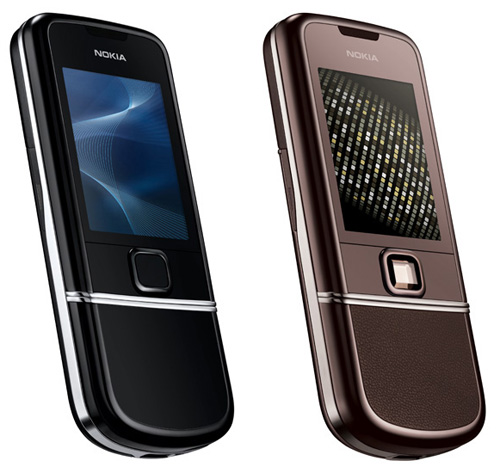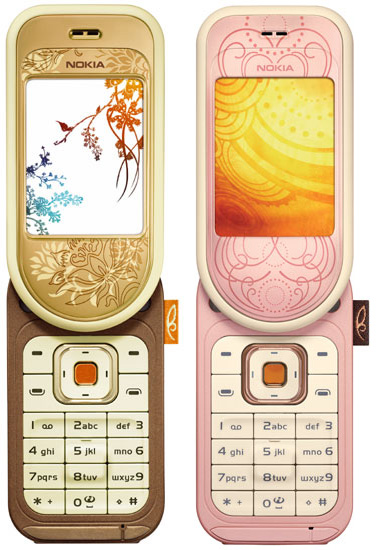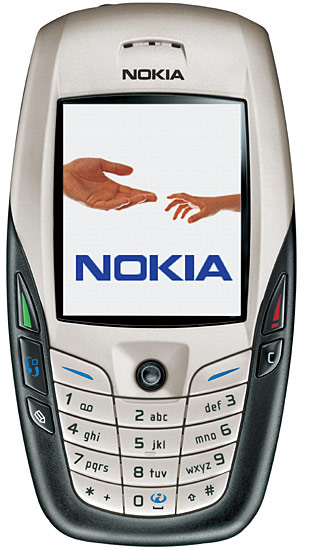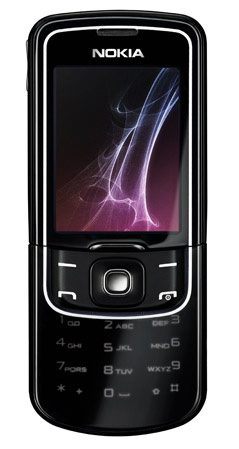|
|
Nokia on the fashion market – marginal notes
After I got down to write the review of the Nokia 7900 Prism, I accidentally stumbled upon the fact that public sources now offer so much information on Nokia moving towards new fashion-savvy products, that it was about time we wrote about it. At first I had a thought that it would be sufficient to breakdown the Prism’s positioning, make mentions of other products, and all the pieces of the puzzle would click into their places without further effort. However, there is a good chance these bits of information may get smeared in the context of a phone review, whereas a special write-up is more interesting in a couple of ways. That’s how the today’s article has come to life – essentially, it is an analysis based solely on official information, that’s why all products names and indexes have been brought about by our imagination alone, and they may be well different from what we will actually see down the road. This piece is more of cogitation about the future of Nokia’s fashion-conscious handsets with some thoughts on where the maker is headed and what the end of this line is.
Reader agreement. The prices quoted below have nothing to do with the Russian market, as the premiums for Nokia-branded devices here are totally random and are entirely up to the manufacturer himself and distributors. This is a very unique situation that is different from all other markets. That’s why Russia is by no means the benchmark to look after, on top of that the development of new products isn’t targeted at this region either, although it is getting increasingly more attention – why not, when consumers over here can buy this many premium products at such exorbitant margins. Essentially, it’s a perfect market.
Íåìíîãî î ôèëîñîôèè ðîññèéñêèõ ïîòðåáèòåëåé íàïèñàíî â ñòàòüå «Öàðñòâî Nokia 8800», ìàòåðèàë ìîæíî íàéòè çäåñü.
What is “fashion” from Nokia?
Before moving on to the core of this write-up, we need to determine what exactly we are going to look into. For some, being fashionable is the same as having a handset from a reputable brand, like Nokia, in his pocket. Others need at least a 500 Euro worth phone, and the rest can’t imagine a fashion-savvy device that is not released in very limited quantities. So happens that for Nokia the fashion-conscious range is composed of the 7000-series devices and the premium solutions of the 8000-series. While the latter are all fashion from head to toes, the former line-up used to feature experimental models and “feelers”, and in the future we might see more of them. Nevertheless, as of today, the 7000-series comprises of only fashion-savvy phones.
Does a fashion-conscious handset from Nokia necessarily mean there is a certain price standard to meet? By no means, if we approach this matter straightforwardly – the prices for such fashion solutions ranges from 200 Euro to 1300-1400 Euro. Seeing this dispersion, it is natural to start wondering whether price is the key to a fashion-savvy handset. While the answer is “yes”, it is of a relative nature. The price of a Nokia-branded fashion phone is higher than that of its counterpart, which lacks this flavor, in the vendor's portfolio. In other words, there is a relative (rather than absolute) connection between being a fashion device and price. Therefore, we can’t say that every Nokia’s model going for 500 Euro and more is a fashion-savvy phone.
It is about time got down to look into the matters of design, fashion and what designers put into this word. Obviously, every phone has some design to it, and thus they are all fashion-conscious offerings to a certain extent. The division into “ordinary” phones and fashion devices is all made-up and explained only by the maker’s urge to expand own portfolio. However, backing up heftier price tags of its designer products, Nokia throws in better and wider selections of materials for good measure (employing not only plastic, but also metal, leather and synthetic gemstones), as well as design backgrounds for every solution.
Let’s see how it works with a real example from the company’s portfolio. There are two identical products available on the market – the Nokia 6500 Classic and Nokia 7900 Prism, with their spec sheets being nearly the same, while bundled applications and themes are effectively the only things setting them apart. So what is the edge that the Prism holds over the “run-of-the-mill” 6500 Classic, which is taken by many as a pure fashion-savvy solution, despite the Classic suffix and its index?

The Prism’s design, inspired by architecture, various keypad backlight flavours and the light indicator on the top edge with a rainbow of colors at its disposal – this is what makes this phone. The Prism is clad in anodized aluminum with a distinctive pattern, whereas the Nokia 6500 Classic utilizes plastic for its casing. The Prism capitalizes on the emotions of consumers, its design inspiration; in a nutshell it is a real fashion-conscious solution. At the same time, the 6500 Classic is an example of a more utilitarian approach to design. Another thing of interest is the gap between these two price-wise – as of today it makes 40-50 Euro in favor of the Prism, which leads us to a conclusion that its fashion flavor and materials account for around 15 percent of its price. But keep in mind that this is the least possible difference; generally it can range from 15 to 30 percent as far as the 7000-series is concerned. On the other hand, premium phones are unparalleled within the maker’s portfolio, so comparing them with something else is out of the question.
Another thing of note is the consistency in terms of the pricing policy applied to the premium phones, whose price tags never change dramatically. At the same time, price adjustments for the 7000-seires are in keeping with other Nokia-branded offerings, for instance the 6000-series, and follow the same trends.
Men or women?
Now let’s take a gander at the segment of fashion-conscious solutions from a different perspective – genders. Putting it simply, we need to figure out who Nokia’s designer phones are more popular with: men or women. Can you give an answer straight off?
The correct answer is not all that clear-cut, although pretty interesting. The fact is, these days Nokia aims primarily at women with its fashion-savvy solutions. Let’s look into the 7000-series, where the Prism Collection is one of the state-of-the-art offerings. All three phones are obviously more feminine, speaking in favor of this guess are both color flavors and positioning. The only exception is the black version of Nokia 7900 Prism, though the share of men for this particular solution isn’t likely to exceed 20 percent of its aggregated sales. Curiously, the Nokia 6500 Classic is a more masculine phone for that matter – the gender ratio here makes 65 to 35 in favor of men.
Comparing the 6000- and 7000-series, it turns out that the former comprises of more solutions for men and has counterparts in the senior range at that. But why the 7000’s focus is women? Simply because they are more emotional and have propensity for impulse-driven purchases, whereas men are usually more rational in these matters.
The premium segment, however, is a bird of a different color, for it features the Nokia 8800 in its numerous iterations, which make it suitable for both men and women, with the former occupying a slightly bigger share in the user base. To make things even more tangled, let’s throw in the Nokia Arte with its three editions. Its basic variant continues the tradition of the original Nokia 8800, being black and thus fitting everyone. The Sapphire Arte is meant for women (while men will make around 20 percent of all users at best), whereas the Sapphire Arte Black targets primarily men (now the numbers turn round – 20 percent of women for this phone).

Starting with the Nokia 8800 Sirocco Edition, the price of the 8800 devices normally kicked off at 1000 Euro and then went down a little with time. Since the 7000-series has no masculine handsets, and the prices there range from 200 to 450 Euro (like in the Art Deco or L’amour Collection), it turns out men have nothing to choose from in the 450-1000 Euro price bracket as far as Nokia’s portfolio is concerned. And right below is the Classic 6000-series.
But all pieces click into their places when you look at the classifications of consumers that Nokia took on a couple of years ago.

What we are interested in is that two categories, specifically Style Leaders and Technology Leaders are very close together. Translating these consumer groups into models, “Style Leaders” can be characterized by the 7000-series, whereas the company’s most technologically talented solutions, the NSeries, S60-powered smartphones fit the latter group best. And if you put the pricing ladder for the NSeries into the equation, you will see that the 450-1000 Euro bracket is filled up with an array of smartphones, and in fact there is a bevy of solutions to pick from. As Nokia views it, there is no “style” (in its conventional meaning) for men at this price point - only contemporary techno-style.
Art Deco, Art Nouveau, what next?
The first feeler the manufacturer threw out was a curtsy it made to Art Deco in the collection of three fashion-savvy models back in 2004. This experience turned out a success, so they did a lot of thinking about this idea’s development, and these days collections inspired by some particular trend are released on regular basis. I also want to note that we are at the beginning of this line – in the future phone collections heavily based on the arts will be all the rage.
As far as the market for jewelry goes, this concept is now being employed by Frey Wille, an Australian company that designs jewellery items styled after the works of famous artists, as well as African, Egyptian or modern motifs. This is an interesting approach that allows Frey Wille’s product to stand out from the crowd.

As amazing as it sounds, all Nokia’s competitors have been turning a blind eye to this field year in year out, although there are tons of examples on the neighbouring markets, and Nokia’s experience should stand for something as well. Samsung, for one, replicates their models for women and rolls out own collections, such as La’Fleur, however they are dismissing the original idea behind these products and rather adopt positioning, design and so on. Without the idea underpinning these phones, their heritage becomes nothing but air; nevertheless, some solutions from these replicated fashion-savvy collections sell very well, yet it is largely thanks to their own design and specifications, rather than being a part of the product family. In the case of Nokia, it is the other way round – nearly all products in their collections enjoy equal success, supporting each other, thus allowing for a variety of form-factors and price differentiation. That’s where we come across a very vaporous, ephemeral thing, one that no market initiatives or researches can measure – the ideas that manufacturers tie up with their solutions. Essentially, the added value of Nokia-branded fashion-conscious phones is constituted not by features or materials, but, for the most parts, the ideas that have been carried over from the past and refined into a modern handset.
Many are sceptical about Nokia’s approach, however. The Marketing Vice-President of one large phone maker told me the following the other day: “It’s a decent idea, and it is really great that they take inspiration from the arts. But come to think of it, they need to convey this to retailers who, in their turn, should bring these ideas to consumers. In real life this is impossible to do – the links of one chain don’t communicate between each other, so the ideas inside their products eventually vanish”.
Many players on the market share the same opinion to a greater or lesser extent – they don’t view a product is an integral entity, and rather try to break it up into different constituents. But Nokia has taken a risk and won. This way, aiming the core idea only at the target audience, they don’t hope that every shop assistant will have an in-depth knowledge of art or architecture. They are rather conveying it to a certain group of people, while all other consumers should see that some handset is used by artists, actors, creative folks, in other words, those who shape public opinion. Does it work a treat? Definitely. In fact, this is a very clever approach that utilizes bohemia as if they were catalysts, communicating the company’s ideas to the rest of the world. On their way to the mass-market some concepts get lost, they fade, but people keep buying these phones solely because they are so all the rage. For instance, an actress or a singer using some phone is usually enough to make a compelling argument for getting it in the minds of his/her fans.
Year after year I keep getting the impression that phone makers simply lack the vision to investigate the actions of their competition. Looking for images or specifications of some particular model nobody pays much attention to the positioning of fashion-savvy solutions. This vaporous matter is usually overlooked, as they deem it not all that important or noteworthy. This is something they shouldn’t do.
The history tends to repeat itself, and its lessons are all important. Back in September 2004 we saw a phone collection styled after the Art Deco look and feel. Two years later, it was September 2006, three more devices came along, that were inspired by ceramics and ethnic motifs. It doesn’t take a rocket scientist to make a guess that September 2008 will bring another collection under the flags of some other theme. Considering tthe previous inspiration sources of Nokia’s designers, this time around they might opt for futurism, modernism or conservatism. Personally, I see futurism as the best way to go, since this style fits the maker’s current product line-up better, allows getting all models in one boat design-wise, and, among all other things, futurism is regaining popularity these days.
Imagining whey they might showcase this September, I really can’t deduce much as far as design goes, but I can estimate how many models there will be as well as their form-factors. Based on the previous collection, which featured three members, the one on the horizon shouldn’t be off in this sense either. The candybar form-factor is not all that fashionable, hence its price (200 Euro), as it is the least sophisticated model in the series. The second phone will come in the so-hyped and loved rotate-style design, previously employed in the Nokia 7370/7373. Given their 2-year life cycles, September seems like a good time to roll out a replacement. Generally, these two years for the fashion-savvy 7000-series products is what the maker goes by. Last, but not the least, the third model will be a folder – make no mistake about that – with, probably, the Nokia 6500 Classic serving as its prototype. They will charge the maximum for this solution – around 450 Euro when it debuts, whereas the phone in the middle will go for around 350 Euro. Where does all this confidence in prices come from? That’s what they did in earlier collections.
Nokia 7370/7373:

Nokia 6600 Classic:

Some may ask why the top-of-the-line model will come in the folder-type design, rather than slider. It is simple: the latter is a more fashion-savvy solution and is already employed in the Nokia 8600 Luna. On the other hand, there is a possibility this collection will offer this design among all other form-factors, but then the maker will have way too many sliders in its range, so this scenario is highly unlikely.

The only thing we have left to do is think of the indexes Nokia will use for its new collection. I suppose, “75xx” will be just right, for example the Nokia 7560, 7570 and 7590, since this will be in the spirit of the previous collections (as you remember, Nokia never uses “4”, for this number is said to bring bad luck in some Asian countries).
Premium segment – new offering for men
Having created an enormous market for all iterations of the Nokia 8800, the manufacturer ended up a hostage to the situation. It is pressed both by the exorbitant sales and the conservatism of the audience, as the company is afraid to put consumers off with a dramatic change in the design paradigm. The real danger here is that sticking to the idea of successive designs, while altering technological talents for the most part (display, camera etc), will, sooner or later, incline the users to start searching for something new. Not all, but many of them. That’s how the Arte sub-family came along, with its leather finish and a synthetic sapphire. The brown version is aimed largely at women and already debuted on the market in late February - early March. Given its price tag of 1150 Euro (which is even heftier in Russia), this is an interesting way to go, for it is obviously color-keyed to other fashion-savvy accessories and designer clothing out there.
Men should feel content with the Sapphire Arte Black that is slated for release in September (the Sirocco Edition arrived in September, for one) at a price slightly higher than that of the brown edition. While this solution hasn’t been officially announced as yet, you could get a closer look at it in our piece on the Arte family. In case you missed it, see the photos picturing this Arte for men below.


It is obvious to me that the maker is still not ready to roll out a follow up to the Nokia 8900, a top-of-the-line offering among premium phones and aimed at men on top of that - this role is currently assumed by the black Arte. This solution needs some time to generate substantial sales, that’s why the chance that we will see another device any time soon is very slim.
But as far as the lower price bracket for premium solutions is concerned, the Nokia 8600 Luna is somewhat lonely. Releasing an additional phone that would have men as its target audience and go for around 700 Euro seems like a good move. Firstly, that’s what the Luna retailed for upon its release, secondly not all prospective buyers of this solution belong to the “Technology Leaders” category, so they don’t really need such products. While the market capacity for this type of product is not gigantic, it is still there. They could name it “Nokia 8700 Mars”, which would be a fitting index, although this is nothing but our wishful thinking – we will see how the situation around fashion-savvy phones will really unfold with our own eyes very soon. All pieces to the big puzzle will be in place by September 9th 2008, when all announcements will have been made. And I think this year will bring a lot of hot headlines.
Related links:
Eldar Murtazin (eldar@mobile-review.com)
Translated by Oleg Kononosov (oleg.kononosov@mobile-review.com)
Published — 19 March 2008
Have something to add?! Write us... eldar@mobile-review.com
|
News:
[ 31-07 16:21 ]Sir Jony Ive: Apple Isn't In It For The Money
[ 31-07 13:34 ]Video: Nokia Designer Interviews
[ 31-07 13:10 ]RIM To Layoff 3,000 More Employees
[ 30-07 20:59 ]Video: iPhone 5 Housing Shown Off
[ 30-07 19:12 ]Android Fortunes Decline In U.S.
[ 25-07 16:18 ]Why Apple Is Suing Samsung?
[ 25-07 15:53 ]A Few Choice Quotes About Apple ... By Samsung
[ 23-07 20:25 ]Russian iOS Hacker Calls It A Day
[ 23-07 17:40 ]Video: It's Still Not Out, But Galaxy Note 10.1 Gets An Ad
[ 19-07 19:10 ]Another Loss For Nokia: $1 Billion Down In Q2
[ 19-07 17:22 ]British Judge Orders Apple To Run Ads Saying Samsung Did Not Copy Them
[ 19-07 16:57 ]iPhone 5 To Feature Nano-SIM Cards
[ 18-07 14:20 ]What The iPad Could Have Looked Like ...
[ 18-07 13:25 ]App Store Hack Is Still Going Strong Despite Apple's Best Efforts
[ 13-07 12:34 ]Infographic: The (Hypothetical) Sale Of RIM
[ 13-07 11:10 ]Video: iPhone Hacker Makes In-App Purchases Free
[ 12-07 19:50 ]iPhone 5 Images Leak Again
[ 12-07 17:51 ]Android Takes 50%+ Of U.S. And Europe
[ 11-07 16:02 ]Apple Involved In 60% Of Patent Suits
[ 11-07 13:14 ]Video: Kindle Fire Gets A Jelly Bean
Subscribe
|











